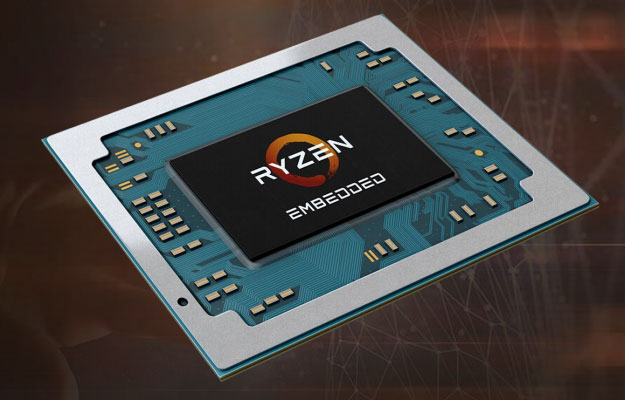AMD Launches Embedded Epyc 3000 And Ryzen V1000 Series Processors To Amplify Zen's Market Reach

AMD is on a mission to service every market possible with its Zen architecture. Up to this point, the company has already provided solutions for desktops, laptops, professional workstations, and datacenters, including several sub-categories in each of those sectors. Now AMD is opening up Zen to even more markets with embedded Epyc and Ryzen solutions, known officially as Epyc Embedded 3000 and Ryzen Embedded V1000.
Adding embedded solutions to its lineup fleshes out AMD's portfolio with modern generation hardware. The new embedded chips join AMD's existing Epyc, Ryzen, and Threadripper processors, further expanding AMD's Zen product stack. They are also natural expansions to the company's Ryzen chips with Vega graphics, which recently launched to desktop after debuting in mobile last year.
The Epyc 3000 and Ryzen V1000 series consist of system-on-chip (SoC) solutions designed to spill into all the nooks and crannies that Zen has not yet touched. Between the two, AMD is effectively expanding Zen's reach into storage, networking, edge computing, casino and arcade gaming, digital signage, routers, and other places not currently serviced by existing Epyc, Ryzen, and Threadripper solutions.
"Today we extend the high-performance x86 ‘Zen’ architecture from PCs, laptops, and the datacenter to networking, storage, and industrial solutions with the AMD Epyc Embedded and AMD Ryzen Embedded product families, delivering transformative performance from the core to the edge. AMD Epyc Embedded 3000 raises the bar in performance for next-generation network functions virtualization, software-defined networking, and networked storage applications. AMD Ryzen Embedded V1000 brings together the ‘Zen’ core architecture and ‘Vega’ graphics architecture to deliver brilliant graphics in a single chip that provides space and power savings for medical imaging, gaming, and industrial systems. With these high-performance products, AMD is ushering in a new age for embedded processors," AMD's Scott Aylor said.
AMD's Epyc 3000 series come in packages consisting of up to 16 Zen x86 cores with up to 32MB of shared L3 cache, up to four indpedendent memory channels, and up to 64 PCIe Gen3 lanes. The chart above outlines fairly wide range of solutions, starting with the 4-core/4-thread Epyc 3101 and ramping up to the 16-core/32-thread Epyc 3451. This gives customers a healthy selection of price and performance options, depending on their needs.
To that end, AMD claims its Epyc 3000 series offers up to 2.7X more performance per dollar than the competition, along with twice the connectivity and enterprise-grade reliability, availability, and serviceability (RAS) features.
The competition, of course, is Intel. AMD highlights the claimed performance gap by comparing its new parts against Intel's Xeon D-1587 and D-1540, a pair of older Broadwell solutions. This is where AMD makes its 2.7X performance per dollar claim, along with up to 50 percent better performance overall.
AMD also touch on how its Eypc 3000 series compares against Intel's newer Skylake-based Xeon D-2191 ($2,407) and D-2141T ($450). Next to those solutions, AMD's Eypc 3451 ($880) and Eypc 3301 ($438) are not only cheaper, they offer more cores, cache, PCIe lanes, and memory channels, while matching boost clocks and exceeding base clocks.
As for AMD's new Ryzen V1000 series, there are four solutions in all, starting with the 2-core/4-thread Ryzen V1202B and ramping up to the 4-core/8-thread V1807B. These chips offer up to 3.6 TFLOPS of performance, giving AMD and its customers a two-fold performance uplift over the previous generation, and three times more graphics muscle than Intel.
The Ryzen V1000 series is based on Raven Ridge, bringing Zen CPU cores and Vega graphics to the embedded market. These new SoCs offer support for four 4K displays and can handle 5K as well, 4K/60fps H.265 encoding and decoding, VP9 decoding, and have up to two 10Gb Ethernet ports.
AMD's ace in its sleeve is obviously graphics, and when compared against various Intel solutions, the Ryzen V1000 comes out ahead by a wide margin. However, AMD also points to the multi-threaded advantage of its new SoCs, as outlined above. AMD's chips also feature Secure Memory Encryption, Secure Encrypted Virtualization, and Secure Boot.
"In addition to performance, security remains a top concern for enterprise customers, whether they are designing top of rack switches, thin client devices or anything in between. AMD Eypc Embedded and AMD Ryzen Embedded processors help protect data at the hardware level with an on-chip secure processor, complemented by hardware validated boot capabilities to help ensure systems are booted up from trusted software," AMD says.
The new parts represent a logical extension of Zen. As AMD has been known to do, it's aiming at delivering competitive solutions as attractive price points. It remains to be seen if its efforts in the embedded category will pay off, but with Zen leading the charge, the company has a decent shot.






